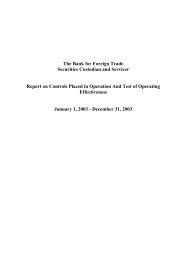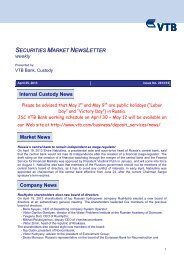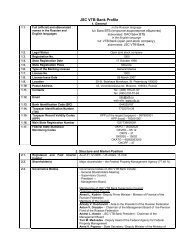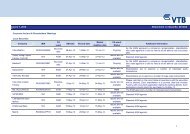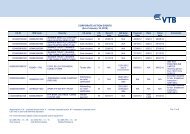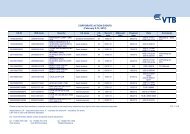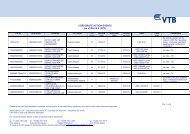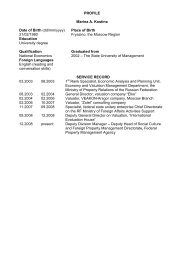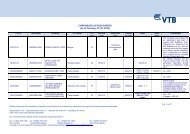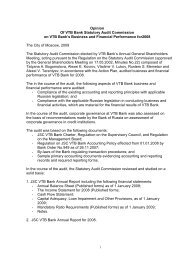Annual report 2011 - VTB
Annual report 2011 - VTB
Annual report 2011 - VTB
- No tags were found...
You also want an ePaper? Increase the reach of your titles
YUMPU automatically turns print PDFs into web optimized ePapers that Google loves.
<strong>VTB</strong> <strong>Annual</strong> Report <strong>2011</strong>4. Management <strong>report</strong>66The VaR assessment is based on an historicalmodelling approach over a period of two years witha ten trading day time horizon and a confidenceinterval of 99%.Price riskThe general principles for managing price risk at <strong>VTB</strong>are as follows:Restricting the size of price risk that is taken on bysetting limits across instruments, portfolios andtypes of transactions;Controlling adherence to established limits andrestrictions for taking on price risk (for example, aminimum discount size on “reverse repo” operationsand margin call conditions);Organisation of ongoing monitoring, analysis and<strong>report</strong>ing of price risk.A quantitative risk assessment is carried out usingthe VaR method and the above parameters forcurrency risk. Original historical data was used forinstruments with a quote history of at least 100trading days in the previous year, no more than tensuccessive trading days without quotes, and an issuedate no later than the beginning of the <strong>report</strong>ing year.The vast majority of such instruments in the Group’sportfolio had a history of 250 trading days in the<strong>report</strong>ing year.For instruments not satisfying these criteria (butnevertheless circulating in the market and carryingmarket risk), the price history used was that ofequivalent (proxy) instruments, expertly selectedusing the following criteria:the proxy instrument is the same type of financialinstrument as the original instrument (bonds/Eurobonds);the issuer of the proxy instrument is in the same sectorand the same country as the original instrument, andthe issuers have comparable credit ratings;the proxy instrument and original instrument aredenominated in the same currency;the proxy instrument and original instrument havecomparable durations.Proxy instruments are used for the VaR calculation inrespect of approximately a quarter of the securities inthe portfolio. In 2010, the Group implemented a VaRassessment method adjusted for diversification.As at 31 December <strong>2011</strong>, this indicator stood atRUB 19.0 billion.Operational riskOperational risk is the risk of loss resulting fromhuman factors, possible flaws in internal processesor inconsistency between them and legislativerequirements, breakdowns in IT and othertechnological systems, or damaging external events(natural disasters).<strong>VTB</strong> Bank’s operational risk management system isdesigned to prevent potential losses and to reducethe possibility of business process failures and theinability to provide high-quality services to the Bank’sclients caused by staff errors, system breakdowns,internal or external fraud or violations of the law.In managing operational risk, the Bank followsthe principles contained in the Bank of Russiaregulations as well as the recommendations of theBasel Committee on Banking Supervision (includingBasel II). To implement its strategy, <strong>VTB</strong> carries outregular procedures to identify, assess, control andlimit operational risk. All significant deficienciesfrom a risk perspective, identified within the internalcontrol system, are subjected to rigorous analysis.Based on the analysis, measures are developed andimplemented to eliminate the causes and sources ofthe risk.To monitor and assess the consolidated operationalrisk, the Bank and its subsidiary financial companieshave implemented unified mechanisms to collectinformation on incidents of operational risk andrelated operating losses, as well as key risk andcontrol indicators.The procedure used by the Group’s subsidiaries tosubmit regular operational risk indicator updates to<strong>VTB</strong> Bank’s centralized risk management service issupported by the Report on Operational Risk moduleon the Group’s Corporate Information System (CIS).This module provides multi-level control over thequality of downloaded data and the possibility tocreate intra-group analytical <strong>report</strong>s with an optionallevel of consolidation.The key methods for limiting operational risk are:Maintaining a complex system of current and followupinternal control that is common to all businessunits and operations throughout the Bank;The regulation of all key operations by internalstandards and codes of practice;The registration and documentation of bankingoperations and transactions and consistent controlover primary documents and operating accounts;The application of the principles of dividing andlimiting the functions, authorities and responsibilitiesof employees; implementation of dual controls;collective decision-making and the setting of limitson the terms and scale of operations;The automation of banking operations based onthe use of high-performance IT systems that areconstantly monitored, and repaired promptly in caseof breakdown;Good systems of physical and information securityand control over access to the Bank’s facilities;A well-managed HR policy, good staff training andeducation.These risk limitation strategies are augmented byinsurance programmes that cover the various typesand scopes of operations. In <strong>2011</strong>, the Group’stotal operational risk insurance amounted toapproximately RUB 137 billion, includingRUB 11 billion coverage of the Bank’s risks. Theseinsurance programmes have traditionally includedinsurance against criminal acts under the FinancialInstitution’s Blanket Bond scheme (includingelectronic and computer crime), insurance ofvaluables during transit and while in storage, liabilityinsurance, and the insurance of the “card business”,including cash machines and cover against bank cardfraud.Programme for implementing Basel IIstandardsIn <strong>2011</strong>, <strong>VTB</strong> Group banks continued working oncomprehensive diagnostics regarding their degree ofreadiness for the implementation of Basel II standardsand a general analysis of the potential impact on thebanks’ activities 1 . Key aspects of this work have beencoordinated at the level of <strong>VTB</strong> Bank (primarily by theRisk Management Department of <strong>VTB</strong>).At the same time, <strong>VTB</strong> Bank and <strong>VTB</strong>24 participatedin a working group for the implementation of theBasel II IRB approach, organised by the Bank ofRussia jointly with the European Union’s leadingexperts on banking regulation.The Bank has also participated in the work ofthe Committee on Basel II Standards and RiskManagement, organised by the Association ofRussian Banks. In particular, a number of topicalmeetings and contacts with Bank of Russiarepresentatives took place within the frameworkof this committee, in which the capabilities andlimitations of the prospective implementation ofBasel II standards were fully assessed.1 <strong>VTB</strong> Group’s Western European banks have been operating according to Basel II standards since 1 January 2008.67



